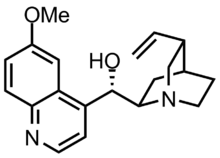Dextromethorphan/quinidine: Difference between revisions
No edit summary |
|||
| Line 55: | Line 55: | ||
*[[Cough]] |
*[[Cough]] |
||
==Other Possible |
==Other Possible Indications== |
||
In June of 2012, drug discovery and development magazine reported that Avanir Pharmaceuticals was planning to test the drug for the treatment of [[anxiety]] associated with [[Alzheimer's Disease]]. |
In June of 2012, drug discovery and development magazine reported that Avanir Pharmaceuticals was planning to test the drug for the treatment of [[anxiety]] associated with [[Alzheimer's Disease]].<ref>{{cite news|title=NNuedexta Testing New Indication|author=|date=June 13, 2011|publisher=CDrug Discovery and Development Magazine|url=http://www.dddmag.com/news/2012/06/nuedexta-testing-new-indication}}</ref> |
||
Revision as of 17:13, 18 December 2012
 | |
 | |
| Clinical data | |
|---|---|
| Trade names | Nuedexta |
| MedlinePlus | a611048 |
| Routes of administration | Oral |
| Legal status | |
| Legal status |
|
| Pharmacokinetic data | |
| Bioavailability | dextromethorphan 11%, quinidine 70-80%. Food has no effect on absorption. |
| Metabolism | Liver, extensive. Dextromethorphan is catalyzed by CYP2D6. Quinidine is metabolized by CYP3A4 and competitively inhibits the metabolism of dextromethorphan to increase and prolong plasma concentrations of dextromethorphan |
| Elimination half-life | dextromethorphan 13h, quinidine 7h |
| Excretion | quinidine 5-20% |
| Identifiers | |
| |
Nuedexta is the first FDA-approved drug for the treatment of Pseudobulbar affect. It is a combination product containing dextromethorphan 12 hydrobromide (an uncompetitive NMDA receptor antagonist and sigma-1 13 agonist) and quinidine sulfate (a CYP450 2D6 inhibitor). Nuedexta was approved in February of 2011 and is marketed exclusively in the United States by Avanir Pharmaceuticals.
Mechanism of Action
Dextromethorphan (DM) is a sigma-1 receptor agonist and an uncompetitive NMDA receptor antagonist. Quinidine increases plasma levels of dextromethorphan by competitively inhibiting cytochrome P450 2D6, which catalyzes a major biotransformation pathway for dextromethorphan. The mechanism by which dextromethorphan exerts therapeutic effects in patients with pseudobulbar affect is unknown.
Dosing
The recommended initial dose is dextromethorphan 20 mg/quinidine 10 mg orally once daily for the first 7 days of therapy. On day 8 and afterward, the recommended daily dose is dextromethorphan 20 mg/quinidine 10 mg orally every 12 hours. Patients should be regularly assessed.
Pharmacokinetics
NUEDEXTA contains dextromethorphan and quinidine, both of which are metabolized primarily by liver enzymes. Quinidine’s primary pharmacological action in NUEDEXTA is to competitively inhibit the metabolism of dextromethorphan catalyzed by CYP2D6 in order to increase and prolong plasma concentrations of dextromethorphan. Studies were conducted with the individual components of NUEDEXTA in healthy subjects to determine single-dose and multiple-dose kinetics of orally administered dextromethorphan hydrobromide in combination with quinidine sulfate. The increase in dextromethorphan levels appeared approximately dose proportional when the dextromethorphan hydrobromide dose increased from 20 mg to 30 mg in the presence of 10 mg of quinidine sulfate.
Interactions
- Desipramine levels increase 8-fold with co-administration
- Paroxetine
- Memantine
Contraindications
- atrioventricular (AV) block, complete, without implanted pacemaker or at high risk of complete AV block
- concomitant use with drugs containing quinidine, quinine, or mefloquine
- concomitant use with drugs that both prolong the QT interval and are metabolized by CYP2D6 (eg, thioridazine, pimozide); effects on QT interval may be increased
- concomitant use with MAOIs or use of MAOIs within 14 days; risk of serious, potentially fatal, drug interactions including serotonin syndrome
- heart failure
- hypersensitivity to dextromethorphan (eg, rash, hives)
- hypersensitivity to quinine, mefloquine, quinidine, or dextromethorphan/quinidine with a history of thrombocytopenia, hepatitis, bone marrow depression or lupus-like syndrome induced by these drugs
- QT interval, prolonged or congenital long QT syndrome or a history suggesting torsades de pointes
Adverse Effects
- Peripheral Edema
- Prolonged QT interval
- Abdominal pain is a commonly reported side effect that resulted in a 2% discontinuation rate
- Diarrhea was reported in 13% of patients
- Vomiting was reported in 5% of patients who received the 20/10mg dosage
- Spasm was commonly reported and lead to 2% of patients discontinuing the drug
- Asthenia
- Cough
Other Possible Indications
In June of 2012, drug discovery and development magazine reported that Avanir Pharmaceuticals was planning to test the drug for the treatment of anxiety associated with Alzheimer's Disease.[1]
- ^ "NNuedexta Testing New Indication". CDrug Discovery and Development Magazine. June 13, 2011.
